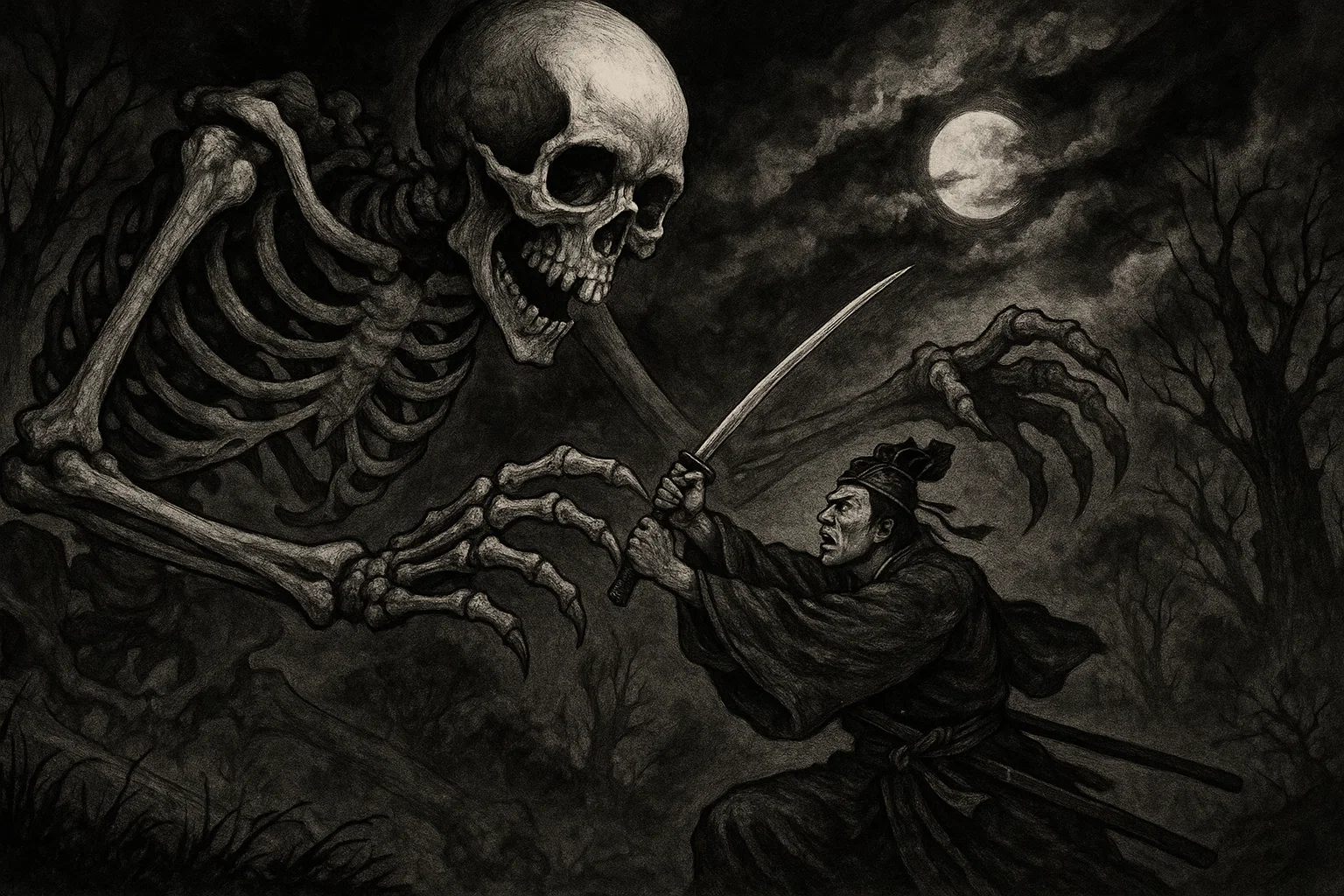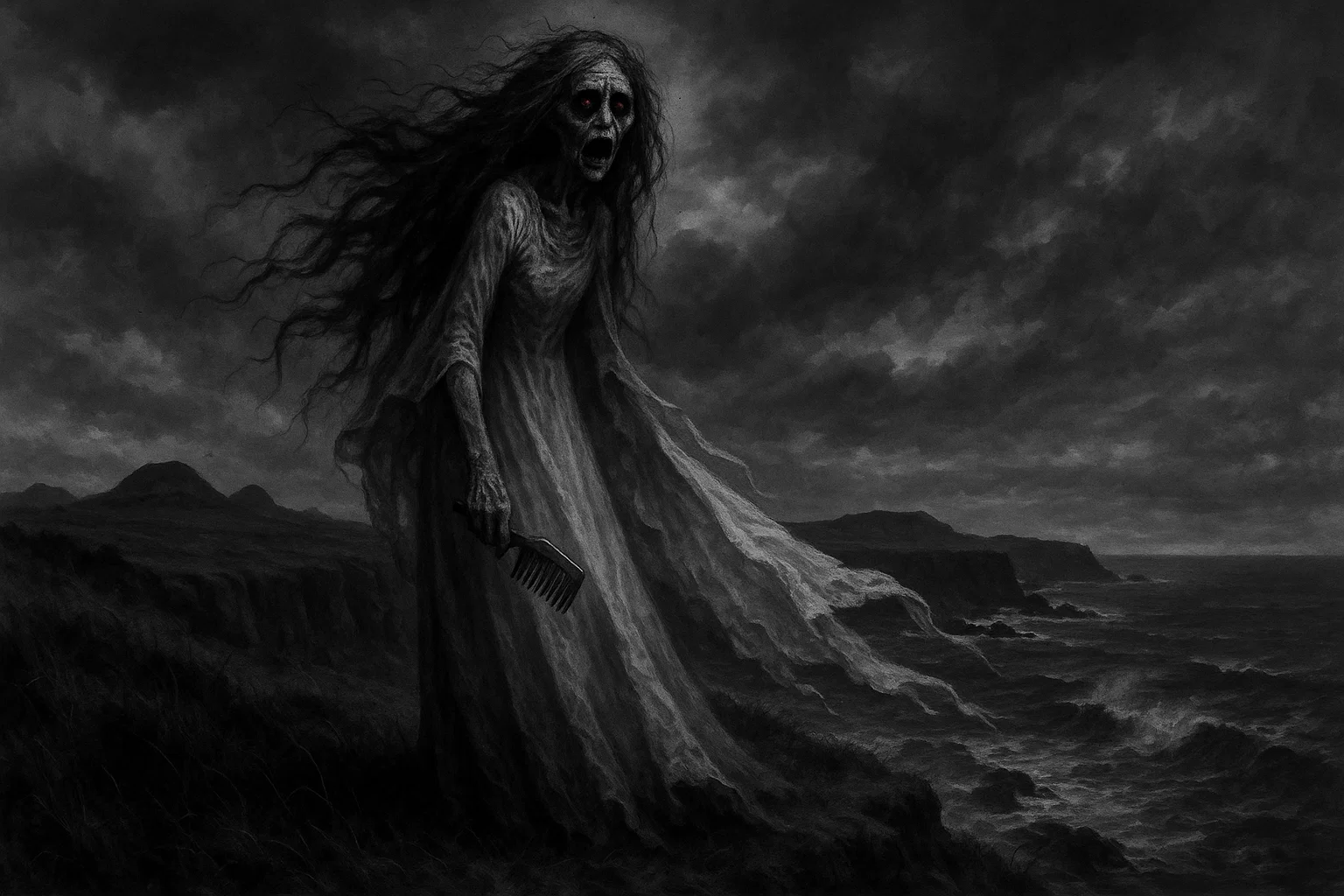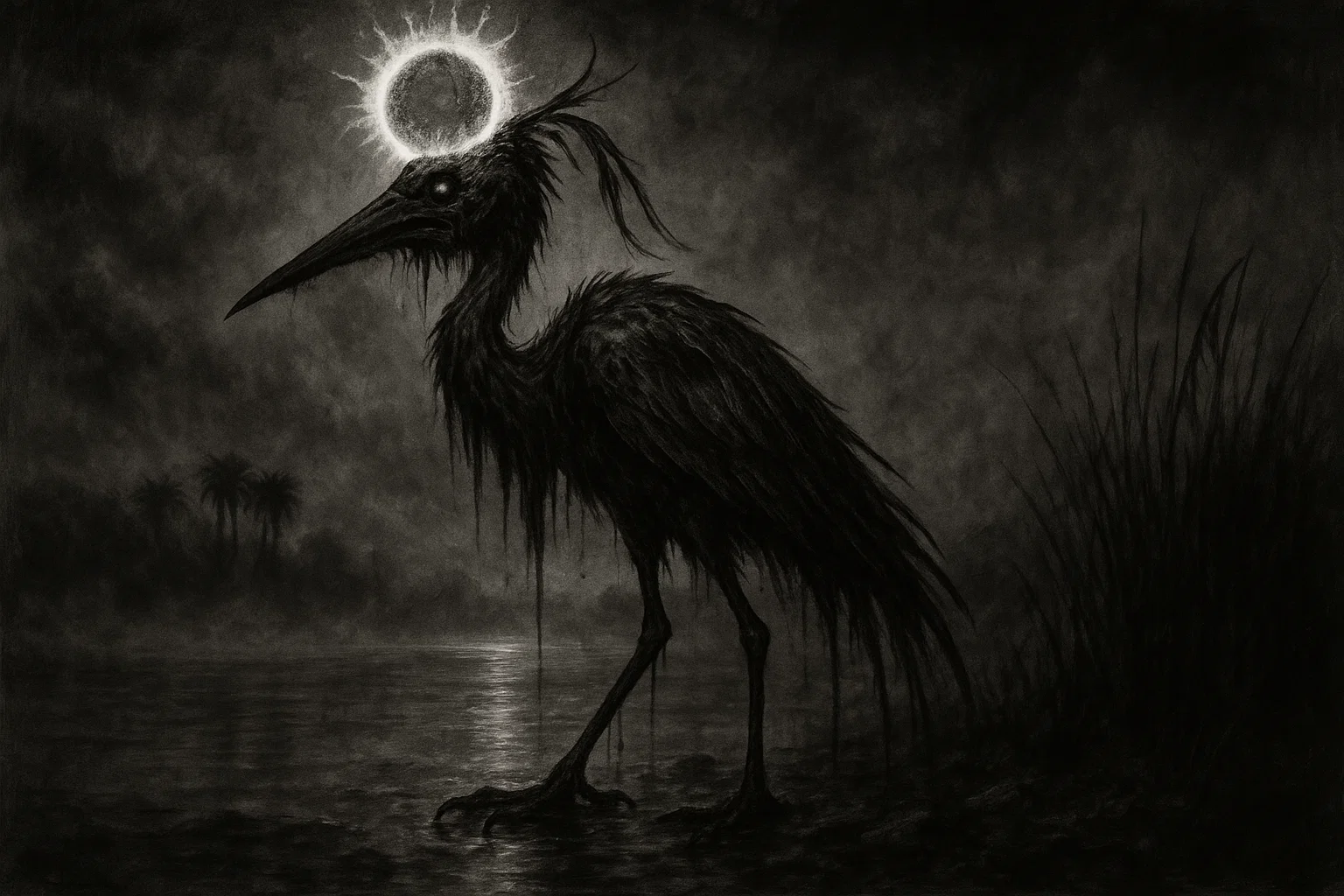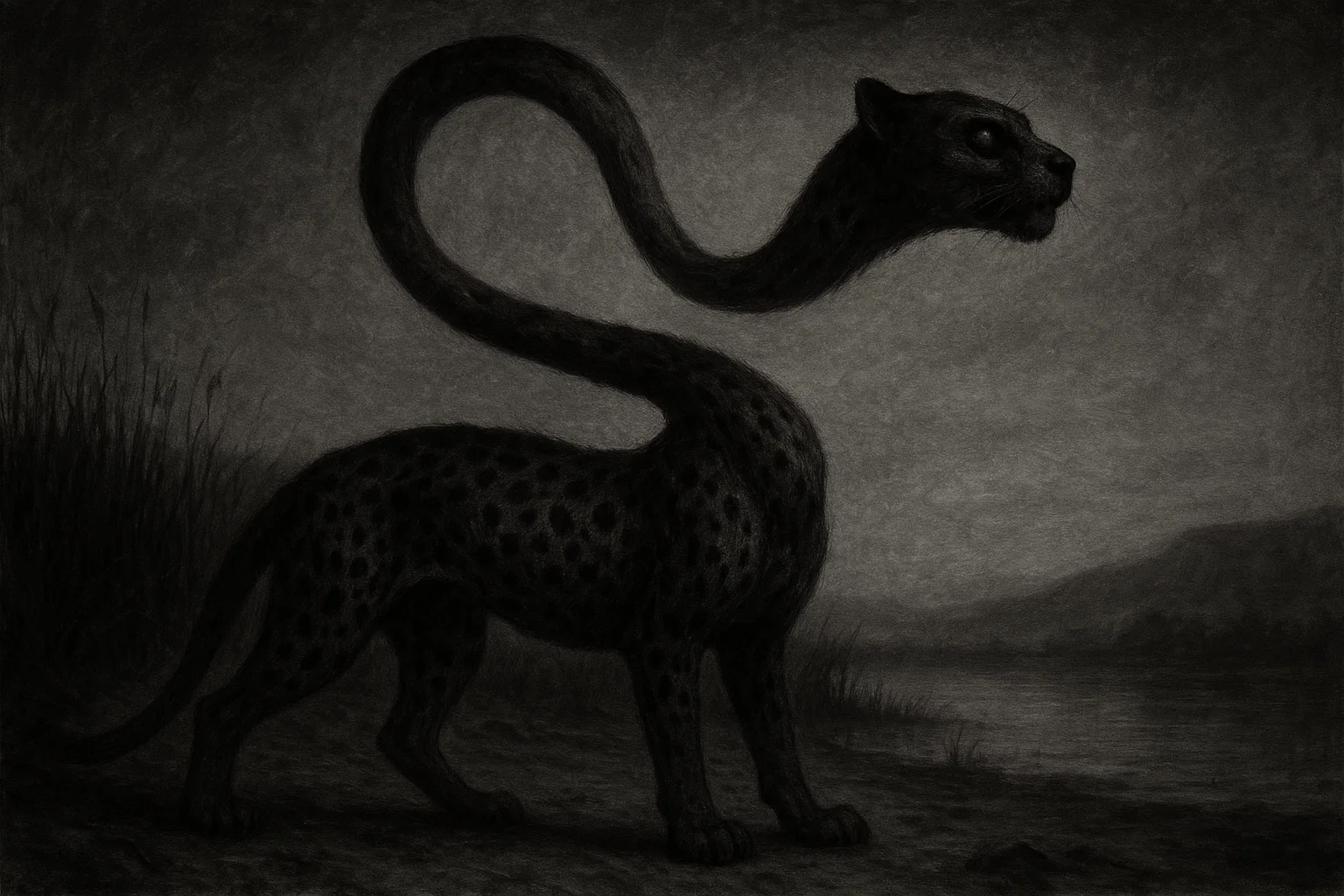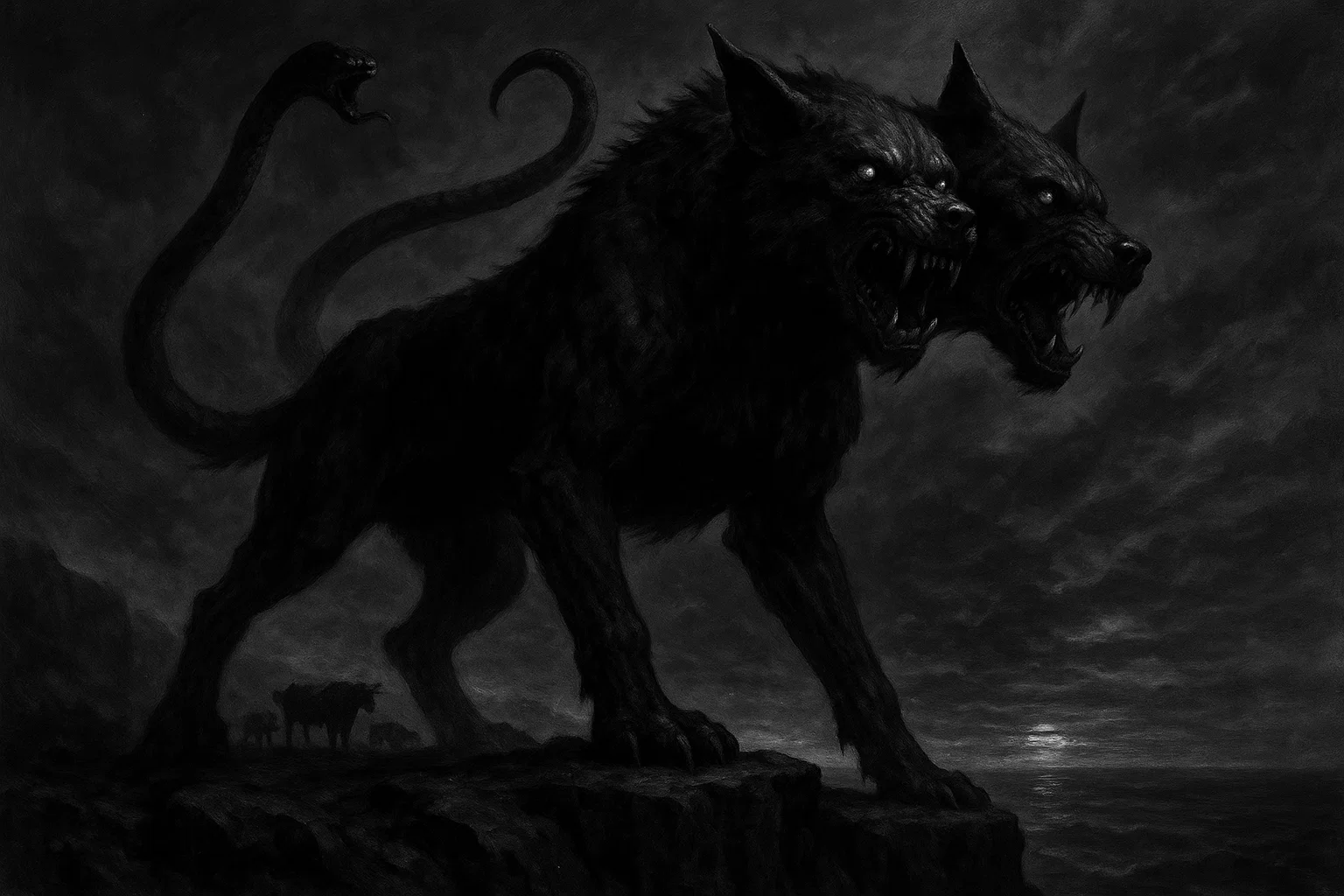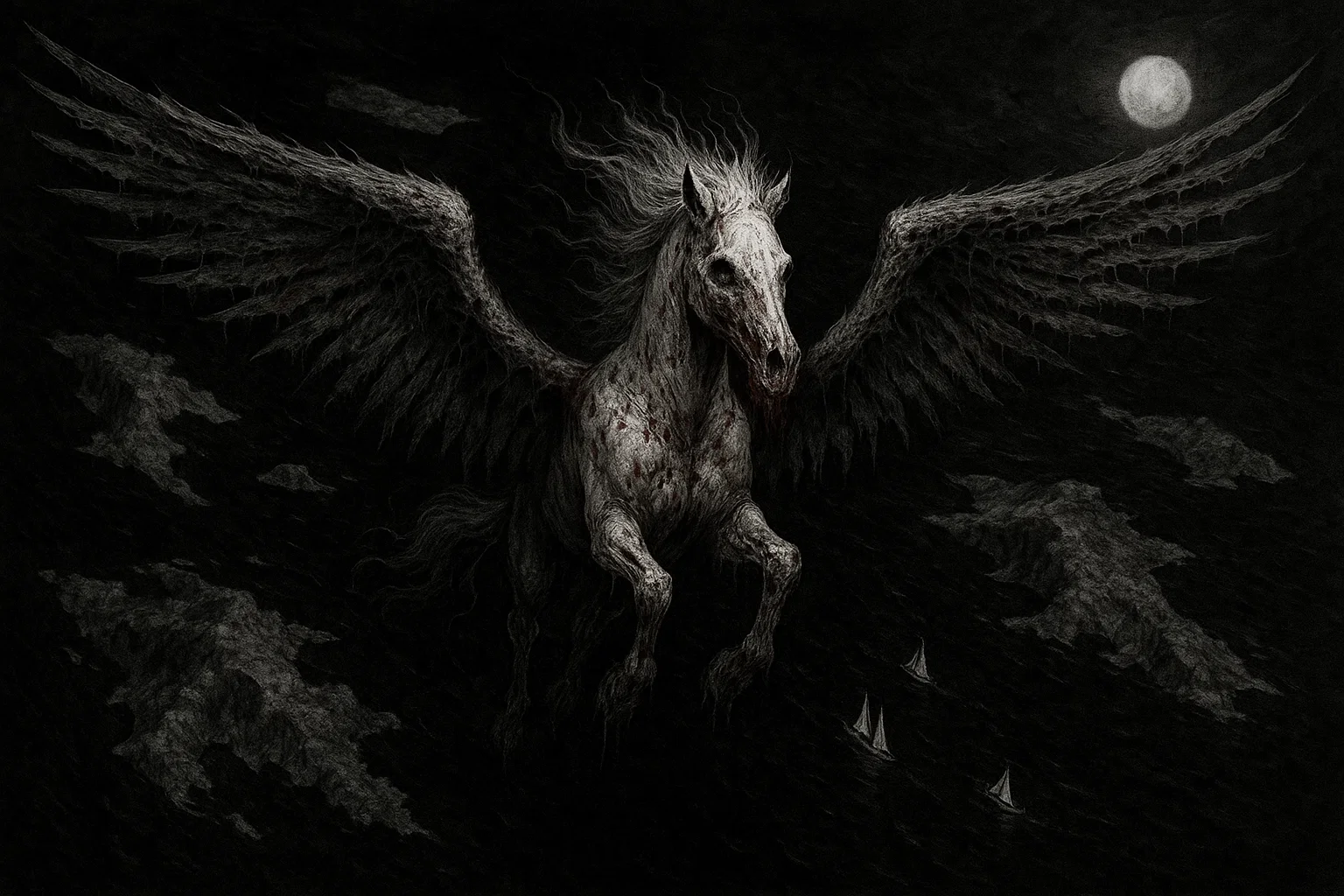In this chilling Japanese horror story, The Samurai’s Curse plunges readers into the eerie aftermath of the Taira no Masakado rebellion, where samurai Hiroshi wanders the desolate fields of Oshu, haunted by guilt and the restless spirits of his fallen clan. As a haunting ringing fills the air and the ominous “gachi gachi” of rattling bones draws near, Hiroshi faces a terrifying yokai born from unburied dead, weaving a tale of vengeance and dread that grips fans of Japanese horror stories with its atmospheric terror and cultural depth.
Summary
Prologue: The Shadow of Rebellion
In the shadowed annals of Japanese folklore, few yokai inspire as much dread as the Gashadokuro—a towering skeleton born from the bones of those who perished without burial, their spirits fused by a collective grudge.
Its origins trace to the 10th-century Taira no Masakado rebellion, a bloody uprising against Kyoto’s imperial court. Masakado, a samurai of noble Taira lineage, was slain in 940 CE, his severed head displayed as a grim trophy.
His daughter, Takiyasha Hime, a sorceress steeped in dark onmyōdō, summoned the first Gashadokuro from the bones of fallen warriors to avenge her father’s death.
This act of sorcery birthed a legend that would haunt Japan for centuries, as similar creatures arose from battlefields where the dead lay unburied, their souls crying for justice.
The tale of Hiroshi, a samurai of the Heian period, unfolds in the war-torn region of Oshu, where the echoes of Masakado’s rebellion linger like a festering wound. This story is a chilling reminder of the consequences of neglecting the fallen—a warning etched in bone and shadow.
Chapter 1: The Lone Wanderer
Hiroshi of the Kanmu Taira clan trudged through the desolate fields of Oshu, his armor dented and stained with the blood of battles past. At thirty-two, he was a seasoned warrior, his face etched with scars and his eyes heavy with grief.
He had fought for his lord, Taira no Kiyoshi, against the rebellious forces of Taira no Masakado, whose uprising had shaken the region. The battle, fought under a crimson sky, had been catastrophic.
Hiroshi’s clan, loyal to the imperial court, was decimated—his lord slain, his brothers-in-arms cut down, their bodies left to rot in the chaos of retreat. Hiroshi, one of the few survivors, carried the weight of their deaths like a stone in his chest.
Why had he lived when so many had perished? The question gnawed at him, a quiet torment that fueled his sense of dishonor.
The moon hung low, a pale sickle casting ghostly light over the scarred landscape. Once fertile, the fields were now a graveyard of war’s remnants: shattered katanas, tattered banners fluttering like ghosts, and skeletal remains half-buried in the mud.
The air was thick with the acrid stench of decay, mingling with the chill of the autumn night. Hiroshi’s boots sank into the soft earth, each step a labored echo in the oppressive silence.
He was headed to a distant village, seeking… what? Solace? Redemption? He wasn’t sure. His only companion was his katana, its scabbard worn but comforting against his side.
As midnight passed, a faint ringing stirred in his ears—subtle, like the hum of a temple bell carried on the wind. Hiroshi paused, rubbing his temples with calloused fingers. “Exhaustion,” he muttered, his voice hoarse.
Days without proper rest or food had left him hollow, his body a vessel of duty and regret. But the ringing grew louder, more insistent, piercing his skull like a needle. Then, another sound joined it: a rhythmic “gachi gachi,” like dry bones clattering in a storm. It was faint but unmistakable, growing closer with each heartbeat.
Hiroshi’s hand tightened on his katana’s hilt, his warrior’s instincts flaring. He scanned the horizon, the moonlit path stretching into darkness, its edges blurred by shifting shadows. The air grew colder, a biting chill that seeped into his bones.
A whisper rode the wind—not words, but a feeling: sorrow, rage, accusation. His heart pounded, a drumbeat of dread. He had heard tales of yokai, spirits born from the unrest of the dead, whispered around campfires to frighten young samurai.
“Children’s stories,” he had scoffed, but now, alone in the desolate fields, doubt crept in. What if the tales were true?
You May Also Like: The Crying Boy Painting Curse: Coincidence or Evil?
Chapter 2: The Encounter
The ground trembled beneath Hiroshi’s feet, a low rumble that shook the earth like the footsteps of a god. The ringing in his ears became deafening, drowning out the world—a high-pitched wail that seemed to claw at his mind.
The “gachi gachi” grew louder, a cacophony of clattering bones echoing from all directions, as if the earth itself were rattling. Hiroshi drew his katana, its blade flashing in the moonlight, and braced himself. His breath came in sharp gasps, visible in the frigid air. Whatever was coming, he would face it as a samurai should.
From the shadows emerged a nightmare made manifest—a colossal skeleton, its bones gleaming white under the moon’s sickly glow.
The Gashadokuro towered over Hiroshi, its skeletal frame stretching at least ninety feet, its skull larger than a noble’s hall. Its hollow eye sockets burned with a green flame, casting an eerie light that seemed to pierce his soul.
Each movement produced the chilling “gachi gachi,” as if the bones were alive with malice. The air around the creature warped, reality recoiling from its unnatural presence. The ground groaned under its weight, and the wind carried a stench of decay so potent it made Hiroshi gag.
He froze, his breath caught in his throat. He had faced warlords, bandits, and beasts, but this was no mortal foe. The Gashadokuro was a manifestation of death itself, born from the bones of his fallen comrades—men he had fought beside, laughed with, failed to save.
Their spirits, denied burial, had fused into this monstrosity, their collective grudge pulsing through its skeletal form. Each bone was a testament to a life cut short, a promise broken, a duty unfulfilled.
Hiroshi’s mind raced, memories flooding back: the screams of his clan, the clash of steel, the blood-soaked earth. He recalled the tales of Takiyasha Hime, the sorceress who summoned the first Gashadokuro to avenge her father, Taira no Masakado. Her story, etched in Utagawa Kuniyoshi’s haunting ukiyo-e print, spoke of a giant skeleton unleashed upon Kyoto.
Was this the same creature, or had his clan’s neglect birthed a new horror? The thought filled him with dread, but honor bound him. A samurai did not flee.
“Who… what are you?” Hiroshi whispered, his voice trembling. The Gashadokuro offered no answer, only the relentless “gachi gachi” of its bones.
Its glowing eyes fixed on him, unblinking, accusing. Hiroshi’s grip tightened on his katana, his resolve hardening. “If you are my clan’s curse, then face me!” he shouted, his voice echoing across the silent fields.
Chapter 3: The Attack
With a cry of defiance, Hiroshi charged, his katana flashing like a streak of moonlight. He aimed for the Gashadokuro’s leg, hoping to sever a bone and topple the beast.
The blade sliced through the air, striking with precision—but it passed harmlessly through the bone, as if cutting through mist. The creature stood unmoved, its skeletal form impervious to steel. Hiroshi struck again, desperation fueling his attacks. Each blow was futile, the katana clanging uselessly, sparks flying where steel met bone.
The Gashadokuro let out a sound—half-rattle, half-laugh—a chilling cacophony that shook the night. It reached down with a massive hand, bony fingers forming a cage that closed around Hiroshi with crushing force.
He gasped as his ribs cracked, pain searing through his body like wildfire. His armor crumpled like paper, the metal groaning under the pressure. He slashed wildly, his katana a blur, but the creature’s grip was unyielding, its bones unmarred.
Lifted high into the air, Hiroshi dangled like a broken doll, his vision swimming. He stared into the Gashadokuro’s glowing eyes, their green fire burning with an ancient fury.
It was as if his fallen comrades were gazing back—Kenta, who had shared sake with him; Daichi, who had saved his life; Lord Kiyoshi, whose trust he had failed. Their voices seemed to whisper in the wind: Why did you leave us? Why were we forgotten? Guilt clawed at Hiroshi’s heart, sharper than the pain in his body.
The creature’s jaws opened wide, revealing a maw that led to an abyss of darkness, a void that seemed to swallow light itself. Hiroshi’s thoughts turned to his clan, to the battles fought, to the rites they had been denied. “Forgive me…” he whispered, his voice breaking.
His final scream was one of anguish—not for his fate, but for the dishonor that had birthed this monster.
With a swift, merciless motion, the Gashadokuro’s jaws snapped shut. Hiroshi’s scream was silenced, and a wet crunch echoed through the night.
Blood dripped from the creature’s maw, staining the earth below. The silence that followed was deafening, broken only by the faint “gachi gachi” as the Gashadokuro retreated into the shadows, its glowing eyes fading like dying embers.
You May Also Like: Photographs from Another World | Horror Story
Chapter 4: The Aftermath
Dawn broke over Oshu, painting the fields in hues of gold and crimson. A group of villagers, led by a young farmer named Kenji, ventured onto the path to gather firewood.
They froze at the sight of Hiroshi’s remains—his body mangled, armor shattered, blood pooling in the mud. His katana lay nearby, its blade unmarred but useless. Kenji, barely twenty, clutched his sickle, his face pale. “What could do this?” he whispered, his voice trembling.
The village elder, Taro, a weathered man of sixty with eyes that had seen too much, approached slowly. His hands, gnarled from years of labor, trembled as he knelt beside the body.
“This is the work of the Gashadokuro,” he said, his voice heavy with sorrow. “A yokai born from the bones of our fallen warriors, those denied the peace of burial. Their spirits are restless, their anger a curse upon this land.”
A woman, Hana, stepped forward, her face streaked with tears. Her husband, Jiro, had died in the same battle as Hiroshi’s clan, his body left unburied in the chaos.
“We cannot let this continue,” she said, her voice breaking. “Jiro… all of them… they deserve rest. We must honor them.” Her words carried the weight of a mother’s grief, her hands clutching a small amulet inscribed with Shinto prayers—a gift from Jiro before he marched to war.
Kenji, his courage faltering, asked, “But how can we stop it? It’s… it’s invincible, isn’t it?” His eyes darted to the horizon, as if expecting the Gashadokuro to emerge again.
Taro’s gaze hardened. “The Gashadokuro is no living thing to be fought with steel. It is a spirit, born of grudge. We must appease the dead—give them the rites they were denied. Only then will their anger subside, and the creature return to dust.”
He paused, his voice softening. “And we must remember Takiyasha Hime. Her father, Taira no Masakado, led a rebellion that brought death to thousands. When he was slain, she summoned the first Gashadokuro, seeking vengeance. But her actions only deepened the cycle of suffering. We must break it.”
The villagers nodded, their fear tempered by duty. They organized a mass burial, a task that would take days. Kenji and Hana led the effort, gathering scattered bones from the battlefield.
Each fragment was cleaned with reverence, wrapped in white cloth, and laid in a sacred grove near the village shrine. Priests, led by the stoic Miko Aiko, performed rituals—chanting sutras, burning incense, offering rice to guide the spirits to peace.
The air filled with the sweet, heavy scent of sandalwood, mingling with the villagers’ whispered prayers.
As they worked, a shift came over the fields. The oppressive weight that had lingered seemed to lift, the shadows less menacing. Kenji, wiping sweat from his brow, felt a breeze—gentle, not cold. “Do you think… it’s working?” he asked Hana, his voice hopeful.
She clutched her amulet, her eyes on the grove. “I feel Jiro’s spirit… lighter, somehow. Maybe they’re finding peace.” Whether it was truth or hope, they clung to it, believing their efforts had calmed the restless dead.
You May Also Like: Messages from Beyond | Horror Story
Chapter 5: The Legacy of the Curse
The tale of Hiroshi and the Gashadokuro became a cornerstone of Oshu’s folklore, whispered around hearths and etched into the village’s memory. It was a cautionary tale, a reminder of war’s cost and the necessity of honoring the fallen.
In Japanese culture, burial rites are sacred, ensuring spirits pass to the afterlife without grudge. The Gashadokuro, born from neglect, embodied the terror of failure—a warning to never forget the dead.
The story echoed the legend of Takiyasha Hime, whose summoning of the first Gashadokuro set a grim precedent. Her tale, captured in Utagawa Kuniyoshi’s Takiyasha the Witch and the Skeleton Spectre, depicted her unleashing the creature on Ōya no Tarō Mitsukuni, a warrior sent to crush her rebellion. Though her Gashadokuro was defeated, its legacy lived on, inspiring stories like Hiroshi’s.
The villagers of Oshu never forgot that night. They maintained the sacred grove, offering prayers each Obon to ensure no more Gashadokuro would rise.
Kenji grew into a leader, his fear replaced by resolve, while Hana found solace in tending the graves, her amulet a constant reminder of Jiro. Taro, in his final years, told the story to children, his voice a steady warning: “Honor the dead, or their wrath will find you.”
The tale spread beyond Oshu, carried by travelers and monks, becoming a warning across Japan. It spoke of Hiroshi’s courage, his guilt, and the horror that claimed him—a horror born from bones and neglect, a curse that could only be broken by respect for those who had fallen.

